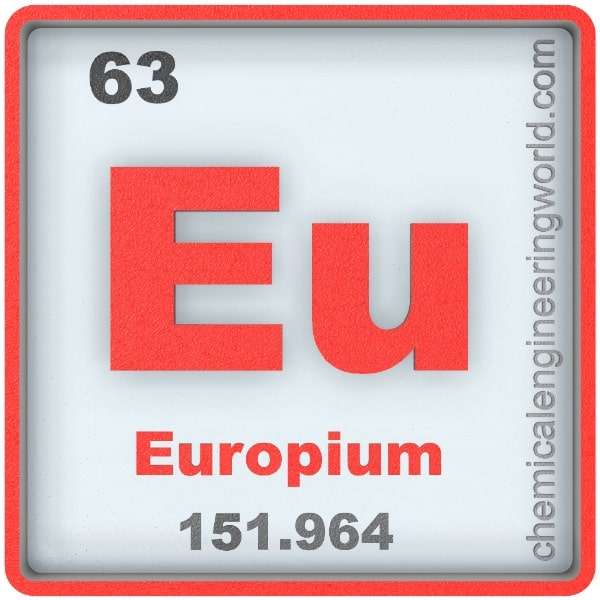Europium Element Properties and Information

Europium Element Properties and Information
Europium is 63rd element on the periodic table. Elements are arranged in the periodic table on the basis of the atomic number. Atomic number is the number of protons in the nucleus of the atom. Europium has an atomic number of 63. It is located in the Group ‘Lanthanides’ and Period 6 of the periodic table of elements. It is denoted by ‘Eu’. It is named after Europe.
Lanthanides have a complex history separation. First cerium was discovered in 1803, the separated sample in and of itself was found to be impure. Two elements were separated from it in 1839; lanthanum and didymium. The didymium itself turned out to be a mixture of elements and they were separated as praseodymium and neodymium in 1879. It still harbored more elements and a sample of rare-earth samarium was extracted. The sample of samarium itself was not totally pure and contained more elements. Gadolinium was discovered in it in 1886. Eugène-Anatole Demarçay carried out painstaking sequence of crystallization of samarium magnesium nitrate in 1901 and separated one more new element, Europium.
The europium is not found in nature in elemental form and no europium-dominant minerals are known. It is found with other lanthanides, the most common minerals being; bastnaesite and monazite.
Physical Properties
- Europium is a soft, ductile metal which is silvery in appearance.
- The atomic mass of europium is 167.26°C.
- The melting point of europium is 1522°C.
- The boiling point of europium is 2510°C.
- The density of europium is 5250 in S.I. units at 20°C.
- The crystals of europium possess body-centered-cubic form.
- The europium exists normally in a divalent state. Application of pressure converts it into a trivalent state. Due to this change the europium displays superconductor behavior.
- Naturally occurring europium is composed of two isotopes; europium-151 and europium-153. They both occur in equal proportions.
Chemical Properties
- Europium is the most reactive among all rare-earth elements.
- Europium oxidizes in air very rapidly; a centimeter sized sample of europium gets completely oxidized within a matter of days.
- Europium has to be kept in an inert environment to prevent it from getting oxidized.
- Europium’s reactivity with water is comparable to calcium. It reacts slowly with cold water and faster with hot water to form a hydroxide.
- Europium ignites in air between temperatures of 150-180°C to form europium(III) oxide.
- Europium compounds exist in +3 oxidation states like all other lanthanides but compounds having oxidation state of +2 are also common.
- Europium reacts with all halogens to form trihalides.
- Europium forms stable chalcogenides and pnictides.
Methods of Production
From Europium(III) oxide: Although europium metal can be separated in the usual way the lanthanides are separated; processing the bastnaesite and monazite ores following ion exchange chromatography there exists an alternative which is commonly followed. The europium is obtained by heating europium (III) oxide under vacuum in presence of excess lanthanum.
Relevance of Chemical and Related Industries
Phosphorescence: The application of europium in industries is limited. Usually the phosphorescence property is exploited.
Relevance in Other Industries
- Lasers: Europium is used as a dopant material for some types of glass in lasers and other optoelectronic applications.
- Electronics: Europium oxide is used as a red phosphor in television sets and fluorescent lamps.
- Quantum memory chips: Europium is used in quantum memory chips which are used to reliably store quantum data for a few days at a time in a hard-disk shaped device which can be shipped around.
- Anti-thermonuclear missiles: Europium has a high neutron capture cross-section and neuron poison chain due to which it is theorised to be useful as a neutron poison in case of a thermo-nuclear threat.
Health Effects on Exposure
- Toxic: Europium salts are mildly toxic upon ingestion.
- Fire hazard: Metal dusts of europium are classified as a fire-hazard.
Effects on Surroundings
Europium poses no threat to plants, animals, or environment.
References:
https://en.wikipedia.org/wiki/Europium#cite_note-13
https://www.lenntech.com/periodic/elements/eu.htm
https://www.rsc.org/periodic-table/element/63/europium
































